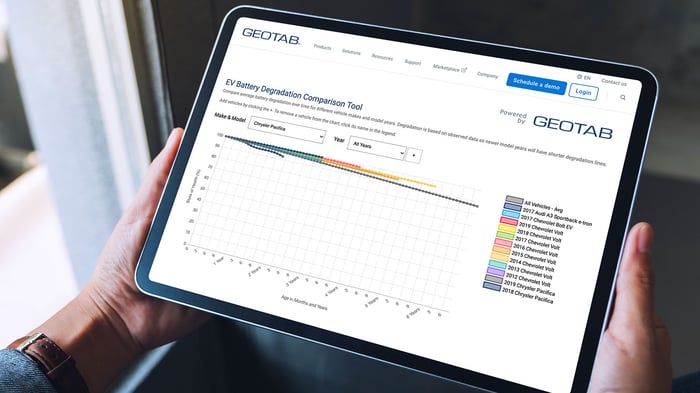
Table of Contents
With more organizations setting firm corporate sustainability targets and government mandates to address climate change, fleet managers, both private and public, are looking to measure and monitor their environmental impact and take action on areas that can be improved.
What is the Green Fleet Dashboard?
The Green Fleet Dashboard (GFD) from Geotab is a vital tool for fleet operators eager to green their fleets and save on fueling costs.
Available on the Geotab Marketplace, the telematics-based dashboard provides fleet managers with the ability to track progress on their fuel use, environmental footprint and electric vehicle (EV) utilization. Managers can use the data insights to monitor the success of green initiatives such as anti-idling policies and electrification and compare progress with similar fleets in the Geotab ecosystem.
Understand your fleet’s performance in sustainability
Using the Green Fleet Dashboard, you can find the answers to important sustainability questions like:
- Is my average fleet fuel economy improving over time?
- How much are my vehicles idling?
- What is the carbon footprint of my ICE (gas) vehicles?
- What driving behaviors do my drivers need to work on?
- How do I compare with similar fleets?
- How can I increase my EV utilization?
- How much are my EVs helping lower cost and emissions?
The Green Fleet Dashboard allows you to analyze performance, identify opportunities for improvement and set a new goal or target. For companies looking to electrify, pair the dashboard with an EV Suitability Assessment to identify the best vehicles to replace with EVs.
Green your fleet by focusing on these five areas
On the surface, a sustainable fleet strategy may not seem cost-effective. Greening your fleet not only reduces your carbon footprint and helps you meet emissions targets, it can actually result in meaningful cost savings too.
There are five major areas of focus when it comes to greening your fleet, regardless of fleet size. Let’s explore them each in more detail:
1. Fuel efficiency
While the importance of fuel efficiency is well known, it can be difficult to identify what steps need to be taken in order to improve it. To start, you must have a clear understanding of how much fuel you’re using and why — after all, you can’t manage what you don’t measure.
Telematics can help you better understand not only how much your fleet is consuming fuel, but also why. With that information in hand, fleet operators can implement effective measures to help improve fuel efficiency. Examples include: monitoring tire inflation and providing real-time driver feedback to curb unwanted behaviors that contribute to inefficiency and dangerous conditions.
Average Internal combustion engine vehicle (ICEV) Fuel Economy trend over time compared to benchmark and best-in-class fleets.
2. Vehicle utilization
While it may be tempting to keep underutilized vehicles in your fleet (e.g., “If I’m not using it, I’m not paying for maintenance or fuel.”), operating a right-sized fleet can provide cost savings, which in turn can be reinvested in the procurement of better-suited vehicles — including EVs.
On the other hand, it’s also important that the vehicles you do have are being used to their full potential. Proper fleet asset utilization can help you identify vehicles that could be repurposed, rotate vehicles to manage downtime and see how conditions impact trips to inform how shifts could be adjusted. For EVs in your fleet, aiming to maximize electric miles and shifting use from combustion vehicles to EV improves your ROI can help lower overall operating costs and emissions.
3. Route planning
Better route planning plays a major role when it comes to fleet efficiency. With efficient route planning, fleets can benefit from a decrease in fuel consumption and reduced stress for drivers, resulting in safer driving practices. The reduced mileage that comes with efficient route planning can also save labor costs associated with dead time between deliveries.
Also, make sure heavily used vehicles are the most efficient available. As different makes, models and sizes of EVs become increasingly available, fleet operators have more options at their disposal to choose the best vehicle for the job.
4. Driver behavior
Improving driving practices contributes greatly to the efficiency of your fleet. Monitoring common issues like harsh braking and cornering, as well as acceleration and speeding can help fleet operators understand the areas to focus on for improvement. Setting up notifications to instill new behaviors, like plugging in EVs at the end of a shift, will help maximize uptime in the fleet. In addition, supporting a more environmentally-friendly driving style not only helps fleets become greener, it also boosts efficiency, resulting in cost savings.
See the average number of hard acceleration incidents compared to similar fleets to help determine if further driver coaching is needed.
5. Electrification
Deploying electric vehicles will have a significant impact on fleet emissions. A good place to start is to identify where EVs are best suited for your fleet and where an EV can do the job at an equivalent or lower total cost of ownership.
To get started, the free EV Suitability Assessment analyzes your fleet to provide EV recommendations.
Simplify green fleet management
Paired with the capabilities of the Green Fleet Dashboard, these five key factors can help fleets from any industry take the first steps toward becoming green fleets.
Originally published on August 24, 2020.







